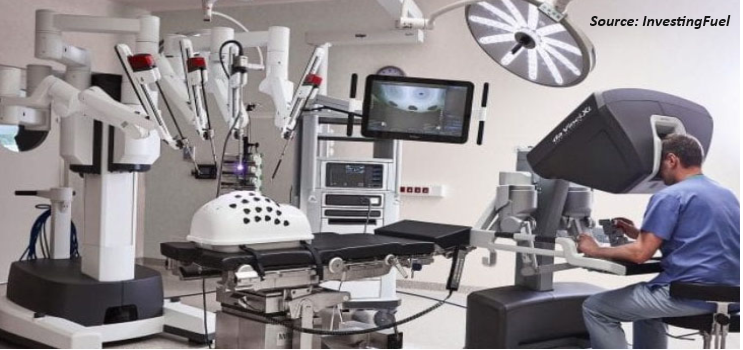
NLP in Healthcare & Life Science Market by Component (Standalone Solutions and Services), by Type (Rule-based, Statistical, Neural, and Hybrid), by Organization Size (Large Enterprises and Small and Medium-Sized Enterprises), by Deployment Mode (On-Premises and Cloud), by Application (Interactive Voice Response, Pattern and Image Recognition, Auto Coding, Classification and Categorization, Text and Speech Analytics and Others), by End-User (Clinical Practitioner, Healthcare Researchers, Healthcare Administrators, Health Insurance & Payers Professionals, Pharmaceutical & Biotech Companies, and Other End Users)– Global Opportunity Analysis and Industry Forecast, 2024 – 2030
Market Definition:
The NLP in Healthcare & Life Science Market size was valued at USD 3.78 billion in 2023 and is predicted to reach USD 22.10 billion by 2030 with a CAGR of 28.7% from 2024-2030. Natural Language Processing (NLP) in the healthcare & life science refers to the application of computational techniques and algorithms to analyze, understand, and extract insights from human language data within these domains.
It encompasses the development and implementation of NLP technologies and solutions tailored specifically for healthcare and life sciences applications. These applications include medical coding, clinical documentation improvement, information extraction from electronic health records (EHRs) and medical literature, patient data analysis, pharmacovigilance, drug discovery, clinical trial recruitment, and personalized medicine. As the demand for efficient and intelligent data processing tools in healthcare and life sciences continues to grow, the NLP market within these sectors is experiencing significant expansion and innovation.
Market Dynamics and Trends
The global adoption of Natural Language Processing (NLP) techniques to extract valuable insights from electronic healthcare records (EHRs) is a significant driving force behind the growth of the NLP in the healthcare & life science market. As healthcare organizations move towards digital record-keeping, there's a growing need for advanced tools to analyze and interpret the large amount of textual data stored within electronic health records (EHRs). NLP technologies are instrumental in addressing this demand by automating critical tasks such as medical coding, clinical documentation improvement, information extraction, and patient data analysis from EHRs.
For instance, in July 2023, Universal Health Services expanded its use of Oracle Health's electronic health record (EHR) system in behavioral health facilities, to enhance patient care and safety practices through the implementation of a unified EHR system across its network of facilities. By harnessing NLP techniques, healthcare providers and life sciences researchers can extract valuable insights from the wealth of data contained within EHRs. This ultimately drives growth and innovation within the market on a global scale.
Moreover, the global growth of the NLP in healthcare & life science market is driven by the increasing adoption of AI-powered services for clinical documentation. These services leverage NLP to automate the extraction of data from medical texts, enhancing efficiency and accuracy in documentation processes. This collaboration between AI and NLP fosters innovation and expansion within the healthcare & life science sectors by providing advanced solutions for clinical documentation needs. As companies increasingly engage in automating clinical documentation, the demand for NLP technologies rises in tandem.
For instance, in July 2023, AWS introduced AWS HealthScribe, a novel generative AI-powered service that automatically generates clinical documentation by utilizing speech recognition and generative AI to transcribe patient-clinician conversations. This innovative technology aims to streamline the creation of clinical notes, alleviating the workload on healthcare professionals and enhancing the overall consultation experience. Such advancements underscore the growing reliance on NLP solutions in healthcare & life science, driving continued market growth and development globally.
However, variability in medical terminology, documentation styles, and data formats across healthcare systems pose challenges for NLP models, leading to reduced accuracy and interoperability. On the contrary, the innovation in generative NLP for drug discovery is expected to create opportunities in the NLP in healthcare & life science market in the coming years. Generative NLP involves uses large language models (LLMs) to analyze vast chemical databases and predict potential interactions between drugs and targets. This accelerates the drug discovery process and potentially leads to the development of more effective treatments.
Market Segmentations and Scope of the Study
The NLP in healthcare & life science market share is segmented on the basis of component, type, organization size, deployment mode, application, and end-user. On the basis of component, the market is divided into standalone solutions and services. On the basis of type, the market is segmented into rule-based, statistical, neural, and hybrid. On the basis of organization size, the market is bifurcated into large enterprises and small and medium-sized enterprises. On the basis of deployment mode, the market is subdivided into on-premise and cloud. On the basis of application, the market is sectioned into interactive voice response, pattern and image recognition, auto coding, classification and categorization, text and speech analytics, and others. On the basis of end-users, the market is segmented into clinical practitioners, healthcare researchers, healthcare administrators, health insurance & payers professionals, pharmaceutical & biotech companies, and other end users. Geographic breakdown and analysis of each of the aforesaid segments include regions comprising North America, Europe, Asia-Pacific, and RoW.
Geographical Analysis
North America holds the dominant share of the NLP in the healthcare & life science market and is expected to continue its dominance during the forecast period. This is attributed to an increase in investments in healthcare technologies across this region. With rising healthcare expenditures, there's a parallel increase in investments in NLP technologies.
According to the U.S. Centers for Medicare & Medicaid Services, 2022, the National Health Expenditure (NHE) per person in the U.S. amounts to USD 13,493 billion, representing 17.3% of the Gross Domestic Product (GDP). These investments empower healthcare providers and life sciences companies to implement NLP-powered solutions for enhancing patient care, streamlining operational workflows, and advancing research initiatives. Such substantial funding fosters the development and implementation of NLP technologies tailored to address the specific requirements of the North American healthcare & life science sectors, consequently fueling growth and fostering innovation within this domain.
Also, the presence of prominent key players such as Oracle Corporation, IBM (Watson Health), and Google (Cloud Healthcare) in North America is a driving force behind the growth of Natural Language Processing (NLP) in the healthcare & life science market. These industry leaders foster innovation, competition, and investment in NLP technologies and solutions. Leveraging their expertise, resources, and market influence, these companies develop advanced NLP platforms, expand their product portfolios, and engage in strategic collaborations with healthcare providers, research institutions, and technology firms.
For instance, in April 2023, Cerner Enviza (an Oracle company) collaborated with the U.S. Food and Drug Administration (FDA) and John Snow Labs to develop innovative AI tools for drug safety and real-world evidence studies. This partnership aims to utilize artificial intelligence (AI) to extract crucial information from clinical notes within electronic health records (EHR), enhancing the understanding of medication effects on large populations.
On the other hand, Asia-Pacific is expected to show a steady rise in the NLP in healthcare & life science propelled by increasing government initiatives such as Ayushman Bharat Digital Mission and e-Hospital, particularly in India, to promote digital health services for maintaining patient health records. NLP technologies facilitate the extraction of insights from digitized health records, enhancing operational efficiency within healthcare organizations in the region.
As the healthcare sector undergoes digitalization, the demand for NLP technologies rises to efficiently manage the growing volume of digital health data. As reported by the Indian Ministry of Health and Family Welfare in 2023, over 50 lakh individuals are utilizing the Ayushman Bharat Health Account (ABHA) app to manage their health records digitally, reflecting the expanding adoption of digital health solutions in the region.
Also, the increase in influx of foreign direct investment (FDI) within the Asia Pacific region is serving as a significant driver propelling the growth of the Natural Language Processing (NLP) market in healthcare & life sciences. This heightened FDI influx increases the financial resources allocated towards research and development initiatives within these critical sectors, including advancements in NLP technologies. The infusion of such financial backing is fundamental in fostering the development of cutting-edge NLP solutions tailored specifically to address the needs of healthcare applications in this region.
Furthermore, the increasing FDI presence also leads to the establishment of robust data centers that are essential for the integration of NLP technologies within healthcare settings. As FDI investment grows in the Asia Pacific, the adoption of NLP in healthcare & life sciences also increase. Data from the Japanese Ministry of Finance, reveals a notable increase in Foreign Direct Investment in Japan, reaching 110.8725 in November 2023. This highlights the influence of FDI on the increasing advancement and adoption of NLP capabilities within the healthcare and life sciences sectors throughout the Asia Pacific region.
Competitive Landscape
The NLP in healthcare & life science market comprises various market key players such as Alphabet Inc., Francisco Partners, Vanguard Group, Inc., Oracle Corporation, SAS Institute Inc., IQVIA Holding Inc., Microsoft (Azure Healthcare), Inovalon Holding, Inc, Averbis GmbH, and Amazon.com, Inc (Amazon Web Services, Inc.). These market players are adopting various strategies including partnerships to maintain their dominance in the global NLP in healthcare & life science market.
For instance, in October 2023, Inovalon, a leading provider of cloud-based software for data-driven healthcare, partnered with Amazon Web Services (AWS) to develop advanced AI/ML solutions for the healthcare industry. The partnership is focused on developing multiple applications across various healthcare sectors, including medical documentation and claim review solutions, which can offer health plans benefits such as reduced effort and cost.
Also, in September 2023, Apollo partnered with Google Cloud to develop a Clinical Intelligence Engine (CIE), to utilize Google Cloud's Vertex AI and generative AI models. This service utilizes data from Apollo Hospitals and Google Cloud's large language models (LLMs) to create a secure solution, keeping patient data within hospital systems.
Additionally, in February 2023, AWS and Hugging Face partnered to enhance Natural Language Processing (NLP) by accelerating the training, fine-tuning, and deployment of large language and vision models used in generative AI applications. This collaboration allows developers to access Hugging Face's advanced models through AWS' SageMaker machine learning platform, making it easier to build high-quality NLP applications that can understand and respond to natural language queries.
Moreover, in September 2022, Oracle Corporation partnered with NVIDIA to tackle the challenge of handling the largest AI and NLP models. This collaboration targets speeding up AI training and processing for customers utilizing NVIDIA GPUs on Oracle Cloud Infrastructure (OCI), leading to significant growth in OCI's infrastructure usage for training large-scale AI models.
KEY BENEFITS
-
The report provides quantitative analysis and estimations of the NLP in healthcare & life science market from 2024 to 2030, which assists in identifying the prevailing market opportunities.
-
The study comprises a deep-dive analysis of the NLP in healthcare & life science market including the current and future trends to depict prevalent investment pockets in the market.
-
Information related to key drivers, restraints, and opportunities and their impact on the NLP in healthcare & life science market is provided in the report.
-
Competitive analysis of the players, along with their market share is provided in the report.
-
SWOT analysis and Porters Five Forces model is elaborated in the study.
-
Value chain analysis in the market study provides a clear picture of roles of stakeholders.
KEY MARKET SEGMENTS
By Component
-
Standalone Solutions
-
Services
By Type
-
Rule-based
-
Statistical
-
Neural
-
Hybrid
By Organization Size
-
Large Enterprises
-
Small and Medium-Sized Enterprises
By Deployment Mode
-
On-Premise
-
Cloud
By Application
-
Interactive Voice Response
-
Pattern and Image Recognition
-
Auto Coding
-
Classification and Categorization
-
Text and Speech Analytics
-
Others
By End User
-
Clinical Practitioner
-
Healthcare Researchers
-
Healthcare Administrators
-
Health Insurance & Payers Professionals
-
Pharmaceutical & Biotech Companies
-
Other End Users
By Region
-
North America
-
The U.S.
-
Canada
-
Mexico
-
-
Europe
-
The UK
-
Germany
-
France
-
Italy
-
Spain
-
Denmark
-
Netherlands
-
Finland
-
Sweden
-
Norway
-
Russia
-
Rest of Europe
-
-
Asia Pacific
-
China
-
Japan
-
India
-
South Korea
-
Australia
-
Indonesia
-
Singapore
-
Taiwan
-
Thailand
-
Rest of Asia Pacific
-
-
RoW
-
Latin America
-
Middle East
-
Africa
-
REPORT SCOPE AND SEGMENTATION:
|
Parameters |
Details |
|
Market Size in 2023 |
USD 3.78 Billion |
|
Revenue Forecast in 2030 |
USD 22.10 Billion |
|
Growth Rate |
CAGR of 28.7% from 2024 to 2030 |
|
Analysis Period |
2023–2030 |
|
Base Year Considered |
2023 |
|
Forecast Period |
2024–2030 |
|
Market Size Estimation |
Billion (USD) |
|
Growth Factors |
|
|
Countries Covered |
28 |
|
Companies Profiled |
10 |
|
Market Share |
Available for 10 companies |
|
Customization Scope |
Free customization (equivalent up to 80 working hours of analysts) after purchase. Addition or alteration to country, regional, and segment scope. |
|
Pricing and Purchase Options |
Avail customized purchase options to meet your exact research needs. |
KEY PLAYERS
-
Alphabet Inc.
-
Francisco Partners
-
Vanguard Group, Inc.
-
Oracle Corporation
-
SAS Institute Inc.
-
IQVIA Holding Inc.
-
Microsoft (Azure Healthcare)
-
Inovalon Holding, Inc.
-
Averbis GmbH
-
Amazon.com, Inc. (Amazon Web Services, Inc.)




 Speak to Our Analyst
Speak to Our Analyst


































